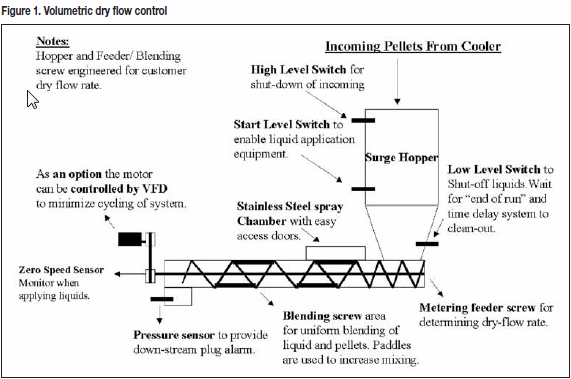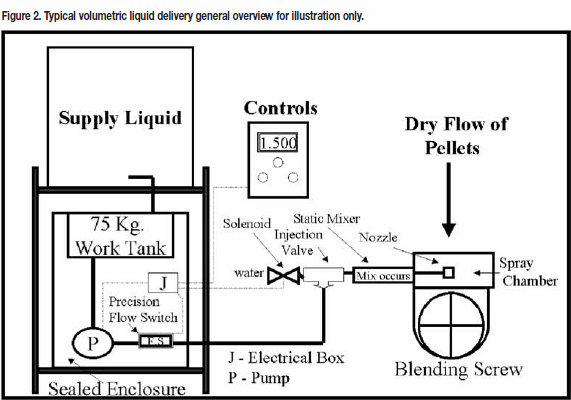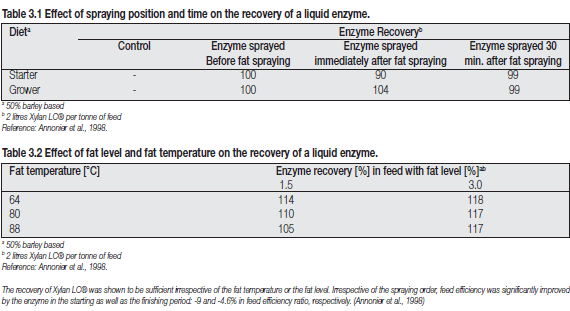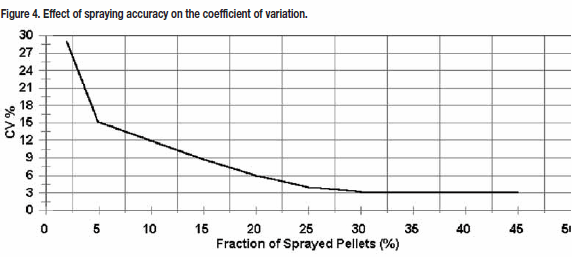Post-Pelleting Liquid Application: A Practical Guide: Part 2
The Application
Dry Flow Measuring
Achieving the desired accuracy is greatly dependent upon the level of accuracy obtained from the
dry-flow measuring device. In general, the steadier the dry flow, the more accurate the liquid can be
applied. (Aicher, 1998).
Several options are available for measuring and controlling the dry flow of pellets or crumbles. It is relatively safe to say that the more money spent on dry flow monitoring, the more accurate the system should be, however, one must consider serviceability and ease of calibration within that equation. For many mills where bulk density of the finished feed is consistent, volumetric measuring (Figure 1) is a proven solution. This cost-effective method uses a surge or buffer hopper with a low and high level switch; the system is calibrated by determining the decreasing amount of pellets over a specified amount of time. Once product reaches the low level switch, a screw auger stops, allowing the bin to fill until product reaches the high level switch and the process then repeats itself.
Several systems employ weigh belts. This method uses a surge bin directly above a belt or mixing screw, which is suspended by a load cell. Weigh belts are not affected by changes in bulk density and can easily be retrofitted into existing mills. They do however, require a high level control system for calibration. Most weight systems are marketed as a package and require a large footprint. Impact Scales - involve calculating weight by the force of pellets hitting a plate. This method has been widely used in many feedmilling applications. These devices are compact. Impact scales should only be installed in constant flow applications or inconsistency will occur. Bulk density changes may impact the calibration.

Newer yet, is a technology that uses a curved chute resting on a sensing element or load cell. The system determines flow by measuring the sum of forces necessary to re-direct the incoming flow of material from near vertical to near horizontal. Hence, a momentum measurement. Realized accuracy of 99.5% or better is achievable. In essence, dry flow measuring is the heart of the application, and inaccuracies are compounded through the remainder of the process. Each of the above methods of monitoring pellet flow will work successfully provided the application of the equipment is correct. It is important to ask questions and provide equipment manufacturers with all the relevant data necessary to design an appropriate system.
Liquid Monitoring And Delivery
Currently, there are three methods employed for monitoring the liquid ingredient: measurement can
be volumetrically, loss-in-weigh or by flow meter. There are advantages and disadvantages to all;
Volumetric (Figure 2) is by far the most cost effective.
This system uses a positive displacement pump
to dispense precise amount by two methods;
a. time base by calculating the amount of liquid delivered over a specific time and relating that amount
in a given minute or hour.
b. Pulse emulation where each stroke of the pump is proportioned to deliver a given amount. The
control system then reads the pulses and records the flow rate.

Because volumetric systems do not have true flow knowledge, it is important that these systems have low level detection and in-line no flow monitors or switches to alarm the operator. Volumetric systems installed correctly can provide superior accuracy with a low cost. Loss-in-weigh is a weight-based system using a positive displacement pump to dispense the precise amount from a day tank.
Some advantages of this method are:
- Liquid densities do not effect the system
- Real-time weight processing
- Inventory is easier to reconcile by weight
The scale offers further benefits by allowing low level monitoring and re-filling set points. Flow Meters are the traditional means of monitoring liquid flow. Reliability and accuracy can be proportional to the money spent on the flow meter. In flow-meter type systems, a positive displacement pump forces liquid into the flow meter producing an electrical out-put to flow. Flow meter based systems require limited space. It is advisable to use a mass flow meter with critical ingredients and those liquids that are subject to density changes with temperature.
Because of the low inclusion (40 - 250 grams per ton) of critical ingredients, it seems logical to dilute additives with water or oil. This will also increase the number of droplets, which will have a positive effect on distribution (Van der Poel and Engelen 1998). In practice, dilution is simply used to increase the accuracy of the installation. Although the objective is a minimum level of water inclusion, an amount of 500 - 1,000 grams per ton add rate has been proven effective.
When it is necessary to mix heat-liable liquids with water, the application system
must meet the following criteria:
1. Mixing should take place as close to the spray application as possible.
2. The system should be purged if extended mix times exist
3. A mechanical static mixer should be used
It is possible to spray one or more liquids together in a post-pelleting installation. Compatibility must be determined. Due to contamination and stability concerns, it is recommended that liquids be dosed independently if from varying suppliers.
At times, addition of enzyme or other heat-liable ingredients will take place just before or just after coating the feed pellets with fat. Even if the pellets are coated with fat first, the low levels of enzyme added may be absorbed (Figure 3). The small amount of water added with the enzyme does not alter the humidity of the pellets significantly, primarily because addition rates are well below one litre/ton (Perry, 1997).
Further, information on the effects and interaction with fat can also be seen in Figure 3. The recovery of Xylan LC® was shown to be sufficient irrespective of the fat temperature or the fat level. (Annonier et al., 1998).

It is practical to apply the critical ingredients prior or in conjunction with the fat or oil. This application will provide a sealed pellet of the ingredient and reduce the need for penetration if applied after fat or oil coating.
Spraying And Mixing
In practice, it is not feasible to disperse the liquid additive over all the pellets.
Homogenous distribution
is achievable but only considering the following:
1. Fines must be minimized. Sieving of the fines prior to application increases accuracy
2. Post mixing after application increases distribution lowering the co-efficient of variation
3. The droplets of liquids must be maximized
Liquid droplets are created by using force and properly selected nozzles. Nozzle sizing is very specialized and many factors must be considered. Nozzles that are not sized correctly can produce over or under spraying and negatively impact the installation. A "one size" fits all approach will not work. Some systems typically used for fat application use a high speed disc which produces a fine atomized mist. This is also an effective method of application and dispersion.
Fines present challenges in post-pelleting systems, particularly in crumb feeds. The wide particle size range and the presence of substantial amounts of fines make the occurrence of segregation practically unavoidable (Barendse,1995). Fine particles that have comparatively large surface/weight ratios will absorb a relatively high percentage of the additive.
Further, fines created or contained in the feed, reduce mixability. In consideration of this, post-pelleting systems should be engineered to minimize pellet degradation during and after spraying.
When spraying or applying liquids, four methods are often used:
1. Mixing Screws - can be retrofitted to allow feed to drop in a flat curtain. A ribbon flight with mixing
bars welded at every pitch at 90 degrees apart can produce the needed curtain. A benchmark
of 20 seconds retention time will produce excellent mixability.
2. A Spray Chamber - is created by use of cones or baffles in a closed compartment. Feed is thinned
to a curtain. For areas with limited space, this may be the only option. Care should be taken to
avoid overspraying. The chamber should be accessible for regular cleaning.
3. Roto Coater type systems have been developed primarily for the application of fat. The design
of these features two discs. Pellets land on the top of a low speed rotating disc which provides
a 360 degree curtain around a second disc. Liquid droplets landing on a second high speed
rotating disc cause a fine atomized mist, which is forced on to the pellets. Several manufacturers
provide similar type systems.
4. Batch mixing - has been used successfully in Europe for adding liquid post-pelleting. The need
for a pre-hopper is required and this creates space problems. These mixers are typically paddle
type and the weighing of liquid and mixing is completed over a short period. The advantage of
this type of system is that it allows for the flexibility of adding both liquid and powder ingredients.
Post mixing after spraying improves uniformity in all application systems. Although some mixing occurs during transportation of the feed, it is expected that the homogeneity will be better when a complete mixing is performed. The object is to have the liquid contact a maximum number of pellets (Aicher, 1998). Sufficient retention time and agitation are necessary to accomplish the desired result (Figure 4).





